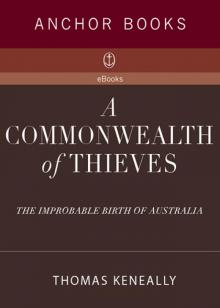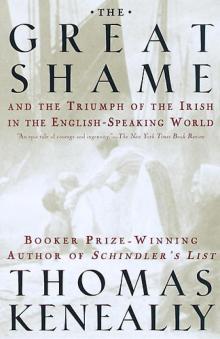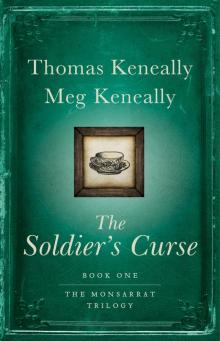- Home
- Thomas Keneally
Australians: Origins to Eureka: 1 Page 4
Australians: Origins to Eureka: 1 Read online
Page 4
Later in the day, the Endeavour intercepted a canoe full of young men and Tupaia invited them aboard. Instead, the Maori hurled every spear they had at the Endeavour. Another volley of musketry killed two or three Maori and another three were taken aboard the ship. ‘When we was once alongside of them we must either have stood to be knocked on the head or else retire and let them go off in triumph . . . I am aware that most humane men who have not experienced things of this nature will censure my conduct,’ wrote Cook. To give him credit, he acknowledged that ‘the people in this boat . . . had given me no just provocation and were totally ignorant of my design’. He was heartsick, but, in an age before anthropology, he was devoted to the idea that his little barque was a travelling tabernacle of European grace and dignity, and that its authority must not be challenged. Europeans, being of a higher culture, should not lose face, even before the most intriguing of savages. These propositions were the armour of his rugged soul, and the uncomfortable question even now is whether he could have endured the long journey without such absolute assumptions. Throughout the entire circumnavigation of both islands, Cook and his crew found the Maori did not understand barter and were likely ‘to plunder’. But Cook and his men did not grasp the Maori tradition of gift exchange, and did not understand it when the Maori activated it unilaterally. Tupaia would in any case assure the crew that the New Zealanders were all liars.
Long after, the Polynesian race would exact its punishment on Cook.
Further north, in a bay in which he hoped to observe the transit of Mercury, his relations with the Maori began better. The telescopes and chronometers were again set up on shore to observe the transit on 9 November, and thereby help determine the longitude of the place. The observations were successful, but soon after a Lieutenant Gore on board became aware a piece of his cloth was missing, and the native who had taken it was back in a canoe, whose rowers brandished their oars in defiance. Gore grabbed a musket and shot the culprit dead. A four-pounder was fired to deter the canoe crew. In later negotiations, the Maori of Mercury Bay received some potato seedlings and were thus the first of their race to make a meal of the earth-apple. A Maori child who experienced the visit would remember later what Cook could not quite appreciate—the bewilderment at the sight of the tupua, the goblins or demons; the shock caused by their firearms and implements; and yet the generosity of gifts and the benignity of the chief, Cook, who touched the heads of Maori children as if he wished them nothing but the best.
During the last month of the year 1769, Cook mapped the coast of the North Island of New Zealand. On the west side of the island the coastline was less hospitable and the seas very rugged. He was looking for an inlet in which he could careen the ship, ‘she being very foul’.
The careening, the running up of the ship on the shore at high tide so that its hull could be repaired and de-barnacled, was done at Ship Cove in Queen Charlotte Sound in the South Island, where Cook found amongst the local Maori fresh-picked human bone, this and other fairly scattered evidence proving to Cook and Banks that the Maori were cannibals: both claim to have seen the human meat of a forearm. Without doubting the sincerity of Cook or Banks, it was true that evidence of cannibalism was shocking but somehow culturally welcome to the European explorer and his ultimate audience—it showed that barbarous nations must be intruded upon for the savages’ own good.
Cook would sail through the passage between the North and the South Islands, proving them separate bodies of land. With two flag-raising ceremonies, he would assume both islands into the mystical body of George III.
Cook had by now fulfilled his orders. He had observed the transit of Venus, hunted for the southern continent where it was presumed to exist—if it existed at all—and would soon complete the charting of New Zealand. He was free in all honour to go home, either by the Cape of Good Hope or by Cape Horn. His instructions declared that in unforeseen emergencies he was to proceed upon the advice of his officers in whichever direction he thought most advantageous to the service. In a great New Zealand fiord surrounded by cloud-concealed walls of near-vertical rock, he called his officers to the cabin for a conference. To honour their uncertainty, he named the place Doubtful Sound. To go home east round the Horn was attractive, not only because that was the fast way, but because he believed it might be a last chance to encounter the Great Southern Continent, the one Dutch New Holland might be part of, but which—should it exist—would soon be encountered to the east and would run far south towards the pole. But he would be in sub-Antarctic ocean, in howling weather and with a leaky ship he would have to careen once more to repair it from the damage the Horn might do it. The other relatively safe option was to head north to New Guinea and Batavia. It was decided instead to steer westward until they fell in with the east coast of New Holland, and if they found it, to follow it northwards. It seems that though he consulted the officers, he may have already determined the result. ‘I had other and more greater objects in view, viz. the discovery of the whole Eastern coast of New Holland.’
TURAGA LANDFALL
On 31 March 1770, Cook left august New Zealand behind in a bank of its own rain clouds, and turned westwards. The great whale of a south land did not exist, but a prodigious substitute waited out there, across the full-blooded currents of the Tasman.
There was little in it for the sailors. At their mess tables and on deck, or in the captain’s cabin if summoned, were the only places they could stand more or less upright. Their sleeping areas fore and aft of their mess were less than 4 feet 6 inches (137 centimetres) in height. Like many British miners, sailors were a race of stoopers. Learning to walk with the ship’s motion while so bent over was a skill, but perforce it was second nature, and even Joseph Banks had to stoop somewhat under the low ceiling of the captain’s cabin, a space Cook seems to have been generous in letting the scientists make use of. There was a saloon amidships, however, where the gentlemen could stand up and sit relatively comfortably—to work or converse or take meals. But the bunk in Banks’s coop, off the main cabin, was so foreshortened that the tall young man had often to stretch out at night on Cook’s floor.
The men who were crossing the Tasman Ocean in search of eastern Australia were a race pygmied by the dimensions of their ship. Even so, Endeavour was a grail loaded with all the European concepts and gifts. Quite apart from the maritime gifts represented by Cook himself, by Molyneux the navigator and the lieutenants, even by the mischievous American midshipman James Magra, there were the concepts of the Enlightenment and the traditions of humanism carried in particular in the tall frame of young Mr Banks. It is worth reviewing what these concepts were in his case. Above all, he possessed a passion for the new. On the continent towards which they were sailing, in the oldest culture on earth, native people practised what would be called ‘maintenance ceremonies’, that is, ceremonies to ensure that a particular area, plentiful in water or plant or animal life, would remain as it was, as the hero ancestor had created it, until the next time the people visited. The limitations of food and water sources in New Holland made it so. Whereas Banks and Solander were ready to do away with limits, and to define their world anew. Above all, Banks believed in the supremacy of scientific and philosophic reason over old orthodoxies of thought and belief, and that reason must be followed even if there was a price involved, such as his giving up spacious London for little Endeavour, and sleeping on Cook’s cabin floor.
A chart Cook owned depicted ‘Nouvelle Holland’ standing rather in the posture of a huge cat leaning forward on its front paws. Van Diemen’s Land was shown on it as those front paws, part of an unmarked straight line running north towards what is known today as Cape York, Australia’s northernmost point. The cartographer did not bother even to indent this line with imagined bays. A few broad-stroke waves in it were left to suggest the possibility of a complex coast.
It was not a coast easily found, and the wind and seas did not help. On the night of 19 April, Cook brought the Endeavour to in case the land was near,
and at five in the morning he set close reeftop sails and merely edged along. And then at six o’clock, the tubercular Lieutenant Zachary Hicks saw the land. It was extending from the north-east to the south westwards, and was ‘long’. Cook named the southernmost point he could see Point Hicks, though it is now known as Cape Everard, very close to the present New South Wales-Victoria border. Further south, he could see nothing where Van Diemen’s Land should have been. So Cook turned north and began charting the coast or, to quote his famous biographer, Beaglehole, ‘brought it out of the shades’.
This was virgin coast for Europeans. The Dutch had not been here, and as far as anyone knew, neither had the Chinese, Makassans, Spanish, Portuguese or anyone else except whatever natives were to be found beyond the string of bold capes and glistening beaches and handsome blue and green hills. Cook would often have to bring the Endeavour to at night, because of the vigorous surf off the beaches.
On the afternoon of 27 April, Cook attempted a first footing on the coast by putting off in a yawl with Banks, Solander and Tupaia and the boat crew. But the surf, as so often on this coast, was too strenuous. The next morning, though, a bay presented itself. He entered it around a low headland, and anchored off the south shore of the place that afternoon. He was watched by a few natives, some of them painted with white stripes. From a boat offshore, Tupaia tried to talk to these people, but their language owed nothing to Polynesian. They belonged to the Eora language group, one of at least 250 languages then spoken by people in the continent known as New Holland. To the gifts Cook had ordered thrown from the boat onto the shore the natives showed hostility. Cook said of them: ‘All they seem’d to want was for us to be gone.’ They knew these visiting spirits on their floating island (turaga) were a sign of cosmic disorder, possibly the dangerous dead returned and rampant. Nonetheless, Cook put in for a landing. His wife’s young cousin, seventeen-year-old Isaac Smith, soon to become a midshipman and ultimately a rear admiral, a young man who shared Cook’s enthusiasm for surveying, was in the boat crew, and as the boat kissed the sandy shore, Cook asked Isaac to jump into the shallows and land first.
From the few empty bark huts that were found, Cook had no inhibitions about removing fizz-gigs, that is, fishing spears. In one shelter they found small children hiding behind a bark shield, and gave them strings of beads. Like many later, these traumatised children of the Gweagal clan thought the wigged and long-haired men to be women spirits fallen from the sky. Dampier had surmised in 1699 that the people he met on the other side of what would prove to be the continent of Australia were relatives of the Negroes. Banks and Cook both took the time in their journals to disagree with this proposition.
Cook could not know what great influence his writings about this place would have in times to come. He said it was ‘capacious, safe and commodious’. The land was low and level, unlike so much of the country they had passed on the way up the coast, and its soil was sandy. Much of the inland was lagoon country, where mangrove shrubs and palm trees predominated. Stingrays sheltered in the shallows in front of a land from which rose, when disturbed, pelicans and dazzling parrots and cockatoos.
Here, just south of the present-day city of Sydney, a young seaman from the Orkney Islands, Thorby Sutherland, died of tuberculosis, and death amongst his crew was still rare enough to enable Cook to name the inner south point of the bay in his memory. By now he had carved on a tree, as he had already done at Mercury Bay in New Zealand, his ship’s name and date of arrival. The great quantity of stingrays found in the bay led to his first calling it Sting Ray’s Harbour. Indeed, the American lieutenant on Endeavour, John Gore, went hunting for them in the shallows. Then Banks and Dr Solander came aboard from their excursions ashore, delirious with the range of new plants they had discovered and which, once they affixed samples to drying paper in the normal way, they then had to take ashore again to dry out in the sun. Moved by their exhilaration, Cook decided he had better call the place Botanist Harbour, and the heads at the entrance Point Solander and Cape Banks. Botanist Harbour soon transmuted to Botany Bay. The most famous location of Georgian botany would thus bear the name of Banks’s passion and true love, rather than the names of admirals, sailors and bureaucrats (as, for example, Cape Howe and Batemans Bay), or names based on natural appearance (Point Upright, Long Nose, Red Point). Cook also left guidance for future navigators in some of his names: Point Danger, Mount Warning, Point Lookout.
Banks would end up giving his name in particular to a genus of plant which grew up and down this coastline and which would be an iconic plant of the Australian bush, one of those definite markers which said this place is not an imitation of England, nor even of the rest of known creation. The Banksia serrata, for example, is gnarled and knobbly, has long leaves with serrated edges, and large, thick flowering fronds, yellow-green and rich in nectar. When the flower dies, the old cone resembles a many-mouthed black villain, and one wonders if it was used as a toy for millennia by Aboriginal children as it would be by the coming generations of white settler children. The Banksia serrata would have seventy-six related species all carrying Banks’s name.
On the morning of 6 May, helped by a wind change to the south, Endeavour left Botany Bay and had a pleasant coastal run. Back on land, the various Eora-speaking clans who occupied the shore and immediate hinterland considered the departure a deliverance, a successful and happy exorcism of alien spirits. Cook passed the sandstone heads of an apparently shallow bay or harbour which he named Port Jackson, but did not explore. Northwards, he continued his naming tendencies. Port Stephens on the one hand, Smoky Cape on the other, named because he saw smoke inland behind it, fires lit for hunting purposes on the flood plain by the Thunguddi people, whose time of disruption had not yet come.
TO GANGURRU REGIONS
Banks and Solander remained industrious, and so did the expeditionary artist Sydney Parkinson, the son of a Quaker brewer from Edinburgh, with so much coastline to sketch and so many novel specimens to draw. Cook’s days too must have been extremely busy, as he made his readings on triangulations and added lines to the chart, the very first chart of this coastline. His work was exacting, and he did not fumble his calculations or jump to easy conclusions. Unlike his opinion of Botany Bay, which would later confuse people, his chart of this huge coastline, 2000 kilometres long, was nearly impeccable.
Off Hervey Bay, in what is now Queensland, occurred an incident of grave indiscipline. Richard Orton, the captain’s clerk, was so drunk that ‘some malicious person or persons in the ship’ were able to steal all his clothes and dock part of both his ear lobes. Cook suspected that the culprit was the American midshipman, Mr Magra. Investigations could not prove it, even though Magra had once or twice before ‘in their drunken frolics’ cut off Orton’s clothing, and had said ‘that if it was not for the law he would murder him’. Molyneux, the master navigator, also drank a great deal.
Cook considered the cutting of Orton ‘the greatest insult [that] could be offered to my authority in this ship, as I have always been ready to hear and redress every complaint that has been made against any person in the ship’. It was interesting that at this great remove from England, Magra and Cook had no doubt that the law prevailed. Some relationships aboard might have been turning rancid, but the travelling was now rendered particularly complicated by the Barrier Reef and the great number of islands all around. One night Cook had to anchor in only 4 metres of water, a mere two and two-thirds fathoms, and a bare half metre more than the ship’s draught. The fact that the natives in this region, influenced by the Melanesians to the north, had outrigger canoes—more formidable than the simple craft of the Eora speakers—made him nervous as well. Far north from the point where Endeavour had encountered the Australian east coast lay a tropic cape Cook named Tribulation, ‘because here began all our troubles’.
The Barrier Reef is not a continuous line of reef but many such lines, and it does not always lie parallel to the coast. To the south it lies further offshore. But by Cape Tri
bulation the reef cramped Cook in.
It was a splendid night, 12 June, and a man was continuously throwing lead from the bows. The ship now crept on and a little after ten o’clock the man in the bows roared ‘Seventeen fathoms!’ and before he could swing again, the ship suddenly struck reef. Everything heavy that could be thrown overboard was—the yards and the topmasts were taken down and anchors taken out of the ship with the hope that they could be used for heaving her off. Just a ship’s length from the starboard side there was twelve fathoms (21.6 metres) and even more astern.
The ship would not budge, and though letting in very little water the sound of her keel and bottom grinding on the coral was disturbing. The fixed guns and their carriages were thrown overboard, iron and stone ballast, all manner of stores that had rotted and unnecessary casks. But at high water she still would not move. At least there was a flat calm, so that the grinding sound ceased. But as the tide went out again, Endeavour heeled to starboard and began to take water. Even the gentlemen took to the pumps. Banks admired the calm of the officers and noticed that the men gave up swearing. Cook hoped that the night tide would be higher. But there was also the horrible chance, given the amount of water that was flooding into the hold, that the ship, its charts and all its news would go straight down. At last, after a day’s desperation, the night tide lifted Endeavour and she floated and was hauled off by her boats. Banks believed that when hauled off she must surely sink and that the gentlemen and crew would be left in a land where they had no hope for subsistence and with no discourse other than with ‘the most unciviliz’d savages perhaps in the world’. But the coral which had holed her had stuck in the hole, and thus plugged Endeavour.

 Confederates
Confederates Flying Hero Class
Flying Hero Class Gossip From the Forest
Gossip From the Forest Schindler's List
Schindler's List Bring Larks and Heroes
Bring Larks and Heroes Australians: Flappers to Vietnam
Australians: Flappers to Vietnam The People's Train
The People's Train Crimes of the Father
Crimes of the Father A Family Madness
A Family Madness A Commonwealth of Thieves
A Commonwealth of Thieves Ned Kelly and the City of Bees
Ned Kelly and the City of Bees A River Town
A River Town Bettany's Book
Bettany's Book Blood Red, Sister Rose: A Novel of the Maid of Orleans
Blood Red, Sister Rose: A Novel of the Maid of Orleans Victim of the Aurora
Victim of the Aurora American Scoundrel American Scoundrel American Scoundrel
American Scoundrel American Scoundrel American Scoundrel Three Cheers for the Paraclete
Three Cheers for the Paraclete Australians: Origins to Eureka: 1
Australians: Origins to Eureka: 1 The Power Game
The Power Game The Chant Of Jimmie Blacksmith
The Chant Of Jimmie Blacksmith The Daughters of Mars
The Daughters of Mars Searching for Schindler
Searching for Schindler The Great Shame: And the Triumph of the Irish in the English-Speaking World
The Great Shame: And the Triumph of the Irish in the English-Speaking World Abraham Lincoln
Abraham Lincoln The Widow and Her Hero
The Widow and Her Hero Eureka to the Diggers
Eureka to the Diggers Shame and the Captives
Shame and the Captives The Survivor
The Survivor Jacko: The Great Intruder
Jacko: The Great Intruder The Book of Science and Antiquities
The Book of Science and Antiquities Homebush Boy
Homebush Boy The Playmaker
The Playmaker To Asmara: A Novel of Africa
To Asmara: A Novel of Africa A Woman of the Inner Sea
A Woman of the Inner Sea The Tyrant's Novel
The Tyrant's Novel Australians
Australians Schindler's Ark
Schindler's Ark The Soldier's Curse
The Soldier's Curse Australians, Volume 3
Australians, Volume 3 Blood Red, Sister Rose
Blood Red, Sister Rose A Victim of the Aurora
A Victim of the Aurora The Unmourned
The Unmourned Australians, Volume 2
Australians, Volume 2 To Asmara
To Asmara